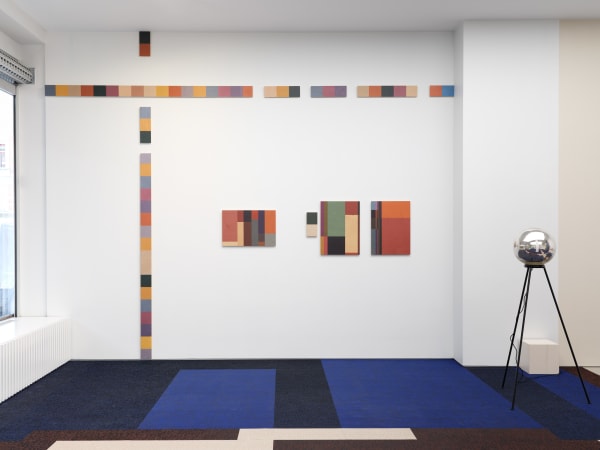Katarina Löfström - Loops and Lamentations: Stockholm
Abstract cuts
Emet Brulin

Narcissus’ lament – I cannot escape – is a cry that testifies to the opposite: the given is not contingent, not possible to change, take apart or to escape. The very image of Narcissus is all too dear to him. Katarina Löfström lets the lament echo. Reinforces and breaks down this dreadful lock into banal code. Dots and dashes. Long and short flashes. A representation, yes, but above all a new expression that enables an opening in the ego’s hermetic relationship with itself, the nation's romanticisation of its sound. When the absurdity of the lock is formalised and taken to its extreme, then one can only laugh at its banality. Such is the power of abstraction; the given is not given.
Entering the gallery space and surrounding oneself with fields of colour on the walls and floor and The Elements’ electronic sounds which contrasts with the fiddles is to decipher abstraction for oneself and how it relates to everyday expressions. The code points back to the viewers themselves – it is up to you, do with it what you can. If Karin Larsson’s tapestry and Narcissus’ lament are puzzle pieces and emblems of our time, Löfström offers an exercise: do not attach yourself to what perception gives, accentuate the given detail and bring the reinforced element together with an unexpected other. Taking apart requires more order, more systematics, than putting together. Löfström’s room and work are thus a much-needed call to, with equal parts playfulness and seriousness, find the openings in and modulate reality.
Emet Brulin is a critic and doctoral candidate in aesthetics.
-

Katarina Löfström
Installation view 'Loops and Lamentations'
Andréhn-Schiptjenko, Stockholm, Sweden, 2025
-

Katarina Löfström
Installation view 'Loops and Lamentations'
Andréhn-Schiptjenko, Stockholm, Sweden, 2025
-

Katarina Löfström
Installation view 'Loops and Lamentations'
Andréhn-Schiptjenko, Stockholm, Sweden, 2025
-

Katarina Löfström
Installation view 'Loops and Lamentations'
Andréhn-Schiptjenko, Stockholm, Sweden, 2025
-

Katarina Löfström
Installation view 'Loops and Lamentations'
Andréhn-Schiptjenko, Stockholm, Sweden, 2025
-

Katarina Löfström
Installation view 'Loops and Lamentations'
Andréhn-Schiptjenko, Stockholm, Sweden, 2025
-

Katarina Löfström
Installation view 'Loops and Lamentations'
Andréhn-Schiptjenko, Stockholm, Sweden, 2025
-

Katarina Löfström
Installation view 'Loops and Lamentations'
Andréhn-Schiptjenko, Stockholm, Sweden, 2025











